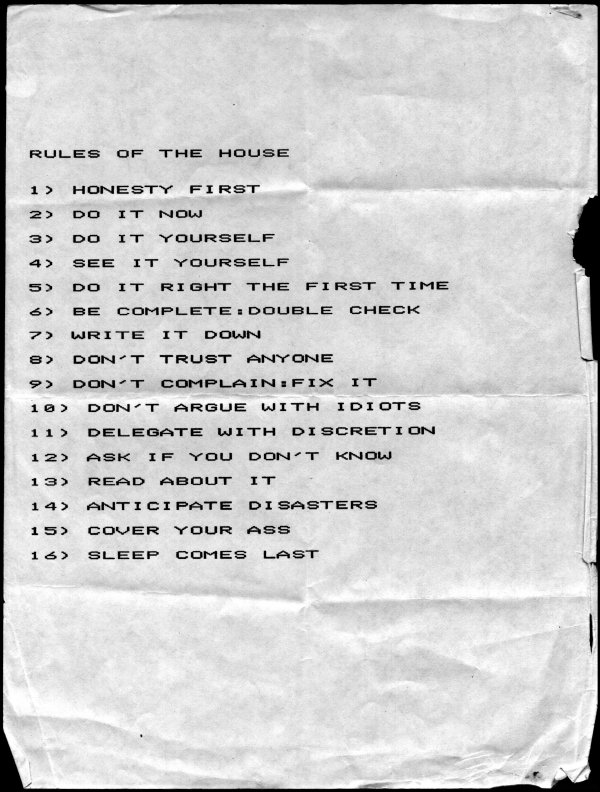|
Some of these rules originated in July 1983. At the time, Dr. Chris Weiss and I were the two 4th year general surgery residents covering the trauma service at Boston City Hospital, the rotation starting July 1. The two of us were discussing our job of transforming the formless new recruits into the kind of battle hardened machines that we had become, he just came out with "Do it now... Do it right the first time... Do it yourself...". I was really taken by the power and simplicity of that, and being a compulsive list maker, I decided to make a litmus test for the proper code of conduct for residents on the trauma service, one that would shine through chaos, be remembered despite exhaustion, and follow the black and white / right and wrong mentality of the service at the time. He and I worked in a few more concepts, and then I wrote the rules on an oversized piece of paper and taped this to the wall of the "trauma suite" - our rough living quarters where we lived like squatters, in an abandoned wing of the old Dowling surgical building of Boston City Hospital. Incredibly, I have found an old picture taken of this first version. This picture is the wall of our quarters in the hospital, probably taken in August 1983:
That year, I took
on the rules as a personal mission. I appended and changed their order,
and finished with a version which I printed out on the dot matrix printer
connected to my workhorse Commodore 64. The following year, as chief surgical
resident, I distributed copies of these to the incoming group of residents
and interns.
Much has happened since. I moved on, and lost track of the list, including my own printed copy. The electronic copy on a 5¼" floppy for my Commodore 64 is long gone, along with that proud machine. Then, In 2000, I was contacted by Dr. Michael Rosenblatt, who had been an intern on my service in 1984 during my chief year. He asked if I knew where these rules had come from, for he had found that across the country, there were different versions of a similar list of rules, and he was trying to track down a possible common point of origin. Mike actually still had the original printout I had given him, folded and worn from use. He was kind enough to send me a picture of it:
He explained that
he had uncovered several similar versions of a "Rules of the House" list
in use across the country. Mike had investigated these and found that all
seemed to have been modified from a list from Miami that had appeared in
the SICU fellows handbook at Jackson Memorial Hospital in Miami.
Mike had then found that Dr. Marc Palter - who had also been
in surgical training at Boston University in the 80's - had brought his
copy from Boston to Miami, and while there, had been the one to include
the list on the front cover of the SICU handbook. From there it and modifications
of it had spread across the country.
Marc has been gracious enough to contact me about this and fill in details of the story from his perspective: "I finished at BU in 1988 and went to the Univ of Miami/Jackson Memorial Medical Center in Miami for two years to do critical care and trauma. During my time there as a fellow I distributed the "rules of the house" to the surgical house staff. Dr. Joseph Civetta (the program director) asked one of the other fellows and myself to write a fellow's manual for the surgical ICU and he asked that we include the rules of the house as part of that manual." "From 1988-1998 about 4-5 fellows per year were trained at Miami in the Surgical ICU and most of these people went on to become involved in critical care in various surgical residency training programs across the US. Naturally they brought the fellows manual with them and distributed it along with the "rules" to the residents they were training. I guess as these residents finish they further spread the "rules" to whatever institution they go to." "I had heard discussions of the 'Rules" on a few occasions at gatherings of general surgeons, but always kept quiet and enjoyed hearing the theories about their origin (some of them pretty amazing). Finally, after the explosion of discussion and theories that appeared on the Trauma-L discussion group I revealed to Mike the BU-Miami connection and that indeed the origin was BU." "Pretty amazing!!"
Charles Eaton MD |

